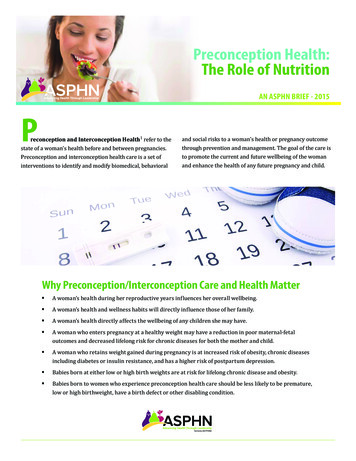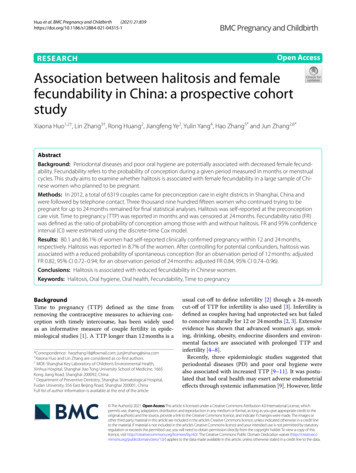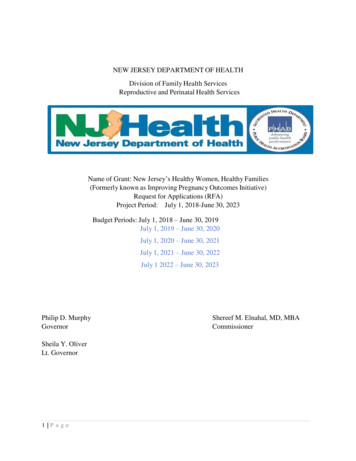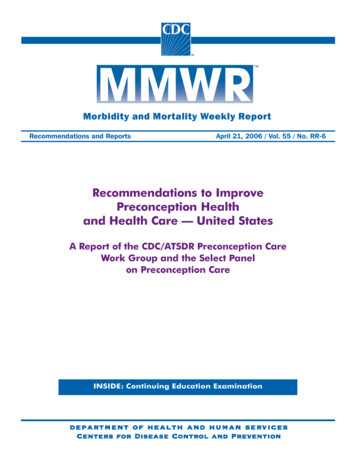
Transcription
PreconceptionCareA guidefor optimizingpregnancyoutcomesThe American College of Obstetriciansand Gynecologists, District II/NY
The American College of Obstetricians and Gynecologists recommend thatall health encounters during a woman’s reproductive years, particularlythose that are a part of preconception care, should include counseling onappropriate health behaviors to optimize pregnancy outcomes and preventmaternal mortality.Checklist of preconception care topics:Education:¡ Smoking, alcohol abuse and other drug use¡ Folic acid supplementation, 400 mcg daily as a standard of careCounseling:¡ Sexually transmitted infections including HIV¡ Family planning and pregnancy spacing¡ Healthy body weight and diet¡ Importance of oral health¡ Increased risk of hepatitis C in those with tattoos and/or body piercings¡ Lead and other environmental and/or occupational exposures¡ Genetic disorders (including cystic fibrosis and sickle cell genotypes)Assessment:¡ Physical assessment including physical examination and medical andfamily history¡ Carrier screening (racial/ethnic background/family history)¡ Immunization record including rubella, hepatitis B, and varicella¡ Complications with past pregnancies (postpartum hemorrhage,thrombotic event, preeclampsia/eclampsia, PIH, gestational diabetes,Rh incompatibility, etc.)¡ Identification and assistance for victims of domestic violence¡ Psychosocial screening for parent readiness2
Table of ContentsA. Behavioral. 41. Alcohol Misuse.42. Domestic Violence.43. Drug Abuse.44. Folic Acid.45. Over-the-Counter Medications.46. Prior Pregnancy Loss.57. Psychosocial Concerns.58. Smoking.5D. Medications. 9E. Sexually Transmitted Infections. 101. Bacteriosis Vaginosis.102. Chlamydia.103. Gonorrhea.104. Hepatitis B.105. Hepatitis C.106. HIV.107. Cervical Cytology.108. Syphilis.10B. Chronic Diseases. 51. Asthma.52. Diabetes.63. Heart Disease.64. Hypothyroidism.65. Obesity.66. Oral Health.6F. Vaccination. 111. Human Papillomavirus.112. Influenza.113. Rubella Seronegativity.114. Varicella.11AppendicesC. Genetics. 71. Cystic Fibrosis.72. Maternal Phenylketonurea.73. Sickle Cell Anemia.7-84. Genetic Disorders- EuropeanJewish Descent.8-9I. Preconception Care Resources.14II. Preconception Health CareSynopsis.15-163
Preconception care is defined as a set of interventions that aim to identifyand modify biomedical, behavioral and social risks to the woman’s health orpregnancy outcome through prevention and management. Certain steps shouldbe taken before conception or early in pregnancy to maximize health outcomes.Consider the following clinical issues. 2A. Behavioral1. A lcohol Misuse: Women who are heavy drinkers (five or more drinks on oneoccasion on five or more days in the past 30 days) have a higher risk ofcardiac and hepatic complications. Any amount of alcohol drinking amongpregnant women also puts the fetus at risk for fetal alcohol syndrome (FAS).Patients should be informed that prenatal alcohol abuse is a preventablecause of birth defects, including mental retardation and neurodevelopmental defects. It is recommended that women are counseled preconceptionallyabout these effects.3,42. Domestic Violence: Trauma, either accidental or intentional is the leadingcause of death in women of reproductive age. 5 Violence often begins duringpregnancy and if it is already present it may escalate and continue through thepostpartum period. Screening women at least once in each trimester is recommended whenever bruising, improbable injury, or depressed mood is noted. 63. D rug Abuse: The use of illicit drugs and alcohol during pregnancy hasadverse effects on the neonate, and these children are at risk for altered neurodevelopmental outcome and poor health status. Detection and treatment ofdrugs and alcohol are essential precursors to appropriate therapeutic interventions in the preconception period. 44. Folic Acid: Neural tube defects (NTDs), such as anencephaly and spina bifida,have multifactorial origins but their etiology often may involve abnormalitiesin homocysteine metabolism that are potentially remediable by folic aciddietary supplementations. The first occurrence of NTDs may be reducedif women of reproductive age take 0.4mg of folic acid daily both beforeconception and during the first trimester of pregnancy. 15. Over-the Counter Medications: Talk to your patient about her use ofover-the-counter medications, herbal products, vitamins, or nutritionalsupplements. Certain vitamins in excess are harmful. For example, vitaminA in doses greater than 10,000 international units has been shown to causesevere birth defects when taken during pregnancy.74
6. Prior Pregnancy Loss: Preconceptional counseling is recommended inwomen who experienced a prior pregnancy loss. During the preconceptionperiod, investigate the factors that may have contributed to the previousnegative outcome and attempt to assuage guilt and help patients resolveany grief from a previous loss. Provide recommendations to the patient thatmay reduce the chances of pregnancy loss. Also, inform patients realisticallyabout the likelihood of successful future childbearing.7. Psychosocial Concerns: Psychosocial issues are nonbiomedical factors thataffect mental and physical well being. Screening for risk factors may helppredict a woman’s attentiveness to personal health matters, her use of prenatal services, and the health status of her offspring. Psychosocial screeningshould include assessment of risk factors, such as: barriers to care, unstablehousing, unintended pregnancy, communication barriers, nutrition, tobaccouse, substance use, depression, safety, intimate partner violence, and stress.8. S moking: Health risks associated with smoking during pregnancy includeintrauterine growth restriction, placenta previa, and abruption placetae.Additionally, adverse pregnancy outcomes may occur including prematurerupture of membranes, low birth weight, and perinatal mortality. Smokers ofreproductive age should be counseled about the associated risks of smokingand the negative outcomes associated with pregnancy.Both cessation of tobacco use and prevention of smoking relapse are key clinical intervention strategies during preconception and pregnancy. A 5-15 minutecounseling session performed by appropriately trained health care providers ismost effective with pregnant women who smoke fewer than 20 cigarettes perday. This intervention, known as the 5 A’s, is appropriate for use during routineprenatal office visits and includes the following five steps: Ask, Advise, Assess,Assist, and Arrange. 8B. CHRONIC DISEASES:1. A sthma: Asthma during pregnancy requires special attention andcomprehensive treatment. Alterations of doses for certain medications suchas corticosteroids may change. Educating patients preconceptionallywould be beneficial to the patients’ pregnancy outcome. Additionally,environmental factors such as allergens (animal dander, house-dust mites,cockroaches, pollens, and indoor molds), tobacco smoke, and indoor/outdoorpollutants (wood-burning stoves of fireplaces, unvented stoves, perfumes,cleaning agents) could exacerbate asthma attacks and should be discussedduring preconception to limit exposures. 95
2. Diabetes: Preconceptional counseling for women with pregestationaldiabetes mellitus is beneficial and cost-effective. Preconceptional counseling should focus on the importance of euglycemic control before pregnancy,as well as the adverse obstetric and maternal outcomes that can result frompoorly controlled diabetes. An evaluation for underlying vasculopathy isadvisable and, in selected patients, may include a retinal examination byan ophthalmologist, a 24-hour urine collection for protein excretion andcreatinine clearance, and electrocardiography. Daily multivitaminsontaining at least 0.4 mg of folic acid are particularly important in womenwith diabetes given their increased risk of neural tube defects. Higherdoses of folic acid may be beneficial in some cases, especially in thepresence of other risk factors for neural tube defects. 103. Heart Disease: Women of reproductive age living with heart diseaseshould be counseled about the potential risks associated with pregnancy.Hypertension in pregnancy, specifically preeclampsia and transienthypertension of pregnancy, is associated with increased rates ofhypertension and coronary heart disease later in life. 114. Hypothyroidism: Women should be counseled preconceptionally abouttreatment during pregnancy. Treatment of hypothyroidism in pregnantwomen is the same as for non-pregnant women and involves administeringlevothyroxine at sufficient dosages to normalize thyroid-stimulatinghormone (TSH) levels. Levothyroxine therapy should be adjusted at fourweek intervals until TSH levels are stable. Pregnancy increases maternalthyroid hormone requirements in women with hypothyroidism diagnosedbefore pregnancy.125. Obesity: Obesity may be defined as a body mass index (BMI) of 30 kg/m2or greater. 13 Obstetricians should provide preconception counseling andeducation about the possible complications and should encourage obesepatients to undertake a weight reduction program before attemptingpregnancy. 14 Even modest reductions in weight may have a beneficial effecton perinatal outcome. During pregnancy, weight reduction is not advisedbut counseling concerning appropriate weight gain is advisable. The goalshould be towards development of lasting diet and exercise habits whichwill help the woman sustain a healthy weight throughout her lifetime.156. Oral Health: Dental care is encouraged as appropriate before and duringpregnancy. Some studies have found an association between periodontaldisease and poor pregnancy outcomes of premature delivery, low birthweight and preeclampsia. Additional research is needed in this area.166
C. GENETICS:1. C ystic Fibrosis (CF): Preconception carrier screening for CF allows carriercouples to consider all reproductive options. The decision to have CF carrierscreening should be with the patient’s informed consent. The following arerecommendations for CF screening: Information about CF screening should be accessible to all couples. CF carrier screening should be offered before conception or early inpregnancy when both partners are Caucasian, European, or of AshkenaziJewish ethnicity. In individuals with a family history of CF, medical records of the affectedfamily members should be obtained. Reproductive partners with CF or congenital bilateral absence of vasdeferens may benefit from an expanded panel of mutations, or a completeanalysis of the CFTR gene by sequencing. When both partners are CF carriers, genetic counseling is recommended toreview reproductive options. CF carrier screening may identify individuals with two CF mutations whohave not been previously diagnosed with CF. 172. Maternal Phenylketonurea (PKU): Routine screening for PKU in newbornsand early dietary therapy with a phenylalanine-restricted diet havemarkedly reduced mental retardation in affected individuals. It has beensuggested that dietary control should be implemented at least three monthsprior to conception to help prevent fetal structural defects, cardiac defects,low birth weight, microcephaly, and mental retardation. 183. Sickle Cell Anemia: Pregnancy in women with sickle cell disease isassociated with an increased risk of morbidity and mortality because ofthe combination of underlying hemolytic anemia and multiorgan dysfunctionassociated with this disorder. Pregnant patients with sickle cell diseaseneed increased prenatal folic acid supplementation. A recommended 4 mgper day of folic acid should be prescribed due to the continual turnoverof red blood cells.197
ACOG recommendations on hemoglobinopathies in pregnancy based ongood and consistent scientific evidence. ( Level A): 19 Individuals of African, Southeast Asian, and Mediterranean descent are atincreased risk for being carriers of hemoglobinopathies and should beoffered carrier screening, and if both parents are determined to be carriers, genetic counseling is recommended. A complete blood count and hemoglobin electrophoresis are the appropriate laboratory tests for screening for hemoglobinopathies. Solubility testsalone are inadequate for screening because they fail to identify importanttransmissible hemoglobin gene abnormalities affecting fetal outcome. Couples at risk for having a child with sickle cell disease or thalassemiashould be offered genetic counseling to review prenatal testing andreproduction options. Prenatal diagnosis of hemoglobinopathies is bestaccomplished by DNA analysis of cultured amniocytes or chorionic villi.4. Genetic Disorders-European Jewish Descent:Seven Recommendations from ACOG Committee on Genetics: 20 The family history of individuals considering pregnancy, or who arealready pregnant, should determine whether either member of the coupleis of Eastern European (Ashkenazi) Jewish ancestry or has a relative withone or more of the genetic conditions. Carrier screening for TSD, Canavan disease, cystic fibrosis, and familialdysautonomia should be offered to Ashkenazi Jewish individuals beforeconception or during early pregnancy so diagnostic testing options maybe considered. Carrier screening is also available for mucolipidosis IV, Niemann-Pickdisease type A, Fanconi anemia group C, Bloom syndrome, andGaucher’s disease. When only one partner is of Ashkenazi Jewish descent, that individualshould be screened first. If it is determined that this individual is a carrier,the other partner should be offered screening. Individuals with positive family history of one of the disorders should beoffered carrier screening for the specific disorder and may benefit fromgenetic counseling.8
When both partners are carriers of one of the disorders, they should bereferred for genetic counseling and offered prenatal diagnosis. Carriercouples should be informed of the disease manifestations, range ofseverity, and availabile treatment options. When an individual is found to be a carrier, his or her relatives are atrisk for carrying the same mutation. The patient should be encouragedto inform his or her relatives of the risk and the availability of carrierscreening. The provider does not need to contact these relatives becausethere is no provider patient relationship with relatives and confidentialitymust be maintained.NOTE: The Wadsworth Laboratory, New York State’s most comprehensivestate laboratory, is currently conducting newborn testing on 40 differentinherited metabolic conditions.D. MEDICATIONS:Medication use should be continued to control disease in women during thepreconception period. Switching medication may be appropriate during thepreconception period if suitable alternatives exist with less risk to the pregnantwoman or fetus.General statements may be made about the teratogenetic potential ofprescription drugs, however, maternal condition and treatment needs shouldbe considered, weighing the benefit to the mother with the risk to the fetus.The U.S. Food and Drug Administration has defined five risk categories( A, B, C, D, X) that are used by manufacturers to rate their products for useduring pregnancy. 21Certain drugs taken preconceptionally may be a risk factor for negativepregnancy outcomes. Some examples of drugs which should be managedcarefully during the preconception period are: Isotretinoins: If used in pregnancy to treat acne, it can result in miscarriage and birth defects. Pregnancy prevention should be practiced inwomen of reproductive age taking these drugs.2 Anti-Epileptic Drugs: Certain types of these drugs are teratogens(e.g. valproic acid).2 Oral Anticoagulants: Drugs for management of blood clotting such asWarafin have shown to be teratogenic. Early exposure during pregnancycould be avoided preconceptionally by switching drugs.29
E. SEXUALLY TRANSMITTED INFECTIONS (STIs):STIs can have harmful effects on pregnant women, their partners, and theirfetuses. All women of reproductive age and their sex partners should beasked about STIs, counseled about the possibility of perinatal infectionsduring pregnancy, and given access to treatment if needed preconceptionallyand during pregnancy.CDC Treatment Guidelines, 2006 221. B acterial Vaginosis (BV): Evaluation for BV might be conducted during thefirst prenatal visit for asymptomatic patients who are at high risk for pretermlabor (e.g., those who have a history of a previous preterm delivery).2. Chlamydia: All pregnant women should be routinely tested for Chlamydiatrachomatis at the first prenatal visit.3. Gonorrhea: All pregnant women at risk for gonorrhea or living in an area inwhich the prevalence of Neisseria gonorrhoeae is high should be tested atthe first prenatal visit for N. gonorrhoeae. A repeat test should be performedduring the third trimester for those at continued risk.4. Hepatitis B: All pregnant women should be routinely tested for hepatitis Bsurface antigen (HBsAg) during an early prenatal visit (e.g. first trimester)in each pregnancy even if previously vaccinated or tested. All laboratoriesthat conduct HBsAg tests should use an HBsAg test that is FDA-clearedand should perform testing according to the manufacturer’s labeling,including testing of initially reactive specimens with a licensed neutralizingconfirmatory test.5. Hepatitis C: All pregnant women at high risk for hepatitis C infection shouldbe tested for hepatitis C antibodies at the first prenatal visit. Women at highrisk include those with a history of injection drug use and those with ahistory of blood transfusion or organ transplantation before 1992.6. HIV: All pregnant women in the United States should be tested for HIVinfection as early in pregnancy as possible.7. Cervical Cytology: Cervical cytology testing should be obtained at the firstprenatal visit if none has been documented during the preceding year.8. S yphilis: A serologic test should be performed on all pregnant womenduring the first prenatal visit.10
F. VACCINATION1. H uman Papillomavirus: The U.S. Food and Drug Administration has approveda quadrivalent human papillomavirus (HPV) vaccine for females aged 9–26years. ACOG recommends the vaccination of females in this age group. Thequadrivalent HPV vaccine has been classified by the FDA as pregnancy category B. Thus, vaccination use during pregnancy is not recommended atthis time. 232. Influenza: Women who will be pregnant during the influenza season(October through mid May) should be vaccinated with the influenza vaccine.The ideal time to administer the vaccine is October and November; however,it is appropriate to vaccinate patients throughout the influenza season aslong as the vaccine supply lasts. This intramuscular, inactivated vaccinemay be used in all three trimesters. Any theoretical risk of the vaccinationis outweighed by its benefits. Likewise, the benefits of the vaccine outweighany unproven potential concerns about traces of thimerosal preservative,which exist only in the multidose vials. It should be noted that the intranasalvaccine spray contains a live, attenuated virus and should not be used duringpregnancy. 243. Rubella Seronegativity: The rubella vaccine is a live attenuated virus andis highly effective with few side effects in rubella susceptible women ofreproductive age. Rubella vaccination is not recommended during pregnancyand women should be advised to avoid conception for one month followingimmunization. Additionally, this vaccine should be administered to allsusceptible women preconceptionally. 244. Varicella: Preconceptional immunization of women to prevent disease inthe offspring, when practical, is preferred to vaccination of pregnant womenwith certain vaccines. The risks involved for pregnant women who contractvaricella include an increased chance of developing severe pneumonia.Risks for the fetus includes congenital varicella (occurs in 2% of fetusesinfected during the second trimester). Live virus vaccine during pregnancy iscontraindicated for varicella vaccination, but no adverse outcomes have beenreported when given during pregnancy. However, specific immune globulinimmunization should be considered for healthy pregnant women exposedto varicella to protect against maternal, not congenital infection. One doseintramuscularly within 96 hours of varicella exposure should be given tothe mother. 2511
Endnotes:1. T he American Academy of Pediatrics and The American College of Obstetricians andGynecologists. Guidelines for Perinatal Care. 5th ed. 2002.2. C DC. Recommendations to Improving Preconception Health and Health Care – United States.MMWR 2006; 55(No RR-06):1-23.3. F loyd LR, O’Connor MJ, Sokol RJ, Bertrand J, Cordero JF. Recognition and Prevention of FetalAlcohol Syndrome. Obstet Gynecol., Nov 2005; 106: 1059-1064.4. A t-risk drinking and illicit drug use: ethical issues in obstetric and gynecologic practice.ACOG Committee Opinion No. 294. American College of Obstetricians and Gynecologists.Obstet Gynecol 2004; 103: 1021-31.5. O bstetric Aspects of Trauma Management. ACOG Educational Bulletin No. 251.American College of Obstetricians and Gynecologists 1998;251: 297-303.6. P sychosocial risk factors: perinatal screening and intervention. ACOG CommitteeOpinion No. 343. American College of Obstetricians and Gynecologists.Obstet Gynecol 2006; 108: 469-77.7. G ood health before pregnancy: preconception care. ACOG Patient Education. American Collegeof Obstetricians and Gynecologists. January 2007.8 . Smoking cessation during pregnancy. ACOG Committee Opinion No. 316, American College ofObstetricians and Gynecologists. Obstet Gynecol 2005;106:883-89. N AEPP Working Group Report on Managing Asthma During Pregnancy: Recommendations forPharmacologic Treatment 2004.10. P regestational diabetes mellitus. ACOG Practice Bulletin No. 60. American Collegeof Obstetricians and Gynecologists. Obstet Gynecol 2005; 105; 675-85.11. Family history of hypertension, heart disease and stroke among women who develop hypertension in pregnancy. American College of Obstetricians and Gynecologists Obstet Gynecol2003; 102: 1366-71.12. T hyroid disease in pregnancy. ACOG Practice Bulletin No. 37. American College ofObstetricians and Gynecologists. Obstet Gynecol 2002; 100: 387-396.13. M arch of Dimes: Maternal Obesity and Pregnancy: Weight Matters, Prepared by theOffice of the Medical Director. April 6, 2005.14. Obesity in pregnancy. ACOG Committee Opinion No. 315. American College of Obstetriciansand Gynecologists. Obstet Gynecol 2005; 106; 671-5.15. C astro LC, Avina RL. Maternal Obestiy and Pregnancy Outcomes. Curr Opin Obstet Gynecol.2002; 14: 601-606.16. B oggesss KA, Lieff SL, Murtha AP, Moss K, Beck J, Offenbacer S. Maternal Periodontal Diseaseis Associated with an Increased Risk for Preeclampsia. Obstet Gynecol 2003; 103: 227-231.12
17. U pdate on carrier screening for cystic fibrois. ACOG Committee Opinion No. 325.American College of Obstetricians and Gynecologists. Obstet Gynecol 2005; 106:1465-818. M aternal phenylketonuria. ACOG Committee Opinion No. 230 American College of Obstetricians and Gynecologists. Jan. 200019. H emoglobinopathies in pregnancy. ACOG Practice Bulletin No. 64. American College of Obstetricians and Gynecologists. Obstet Gynecol 2005;106:203–11.20. P renatal and preconceptional carrier screening for genetic diseases in individuals ofEastern European Jewish descent. ACOG Committee Opinion No. 298. American College ofObstetricians and Gynecologists. Obstet Gynecol 2004; 104:425–8.21. U .S. Food and Drug Administration. Pregnancy labeling.FDA Drug Bulletin 1979;9:23-24 (Level III)22. Centers of Disease Control and Prevention, Sexually Transmitted Diseases; Treatment Guidelines2006. Retrieved at: htm 11/14/2006 23. H uman papillomavirus vaccination. ACOG Committee Opinion No. 344. American Collegeof Obstetricians and Gynecologists.Obstet Gynecol 2006; 108: 699-705.24. I nfluenza vaccine and treatment during pregnancy. ACOG Committee Opinion No. 305.American College of Obstetricians & Gynecologists 2004; 104: 1125-6.25. I mmunization during pregnancy. ACOG Committee Opinion No. 282. American College ofObstetricians and Gynecologists. Obstet Gynecol 2003; 101: 207-12.13
APPENDIX IPRECONCEPTION CARE RESOURCESAmerican College of Obstetricians and Gynecologistswww.acog.orgAmerican Academy of Family Physicianswww.aafp.orgAmerican Academy of Pediatricswww.aap.orgAmerican College of Nurse-Midwiveswww.acnm.orgAmerican Diabetes Associationwww.diabetes.org/home.jspAmerican Society for Reproductive Medicinewww.asrm.orgAntiepileptic drug registrywww.massgeneral.org/aedAssociation of Women’s Health, Obstetric and Neonatal Nurseswww.awhonn.orgThe Centers for Disease Control and .htmMarch of ion.aspNational Birth Defects Prevention Networkwww.nbdpn.orgThe New York State Pregnancy Risk Networkwww.pregnancyrisknetwork.orgPractice Guidelines for Oral Health Care During Pregnancy and Early Childhoodnyhealth.gov/prevention/dental/weblinks oral health.htm14
APPENDIX IIPRECONCEPTION HEALTH CARE SYNOPSISAsk about reproductive intentions at every visit and ascertain risk of anunplanned pregnancy.For women not actively seeking to become pregnant, discuss currentcontraceptive methods and any concerns or problems with that method. 3Preconception checklist 1,2,3Genetic Folic acid supplement (400 mcg routine, 4 mg previous neural tube defect) Carrier screening (racial/ethnic background/family history):– Sickle cell anemia– Cystic fibrosis– Thalassemia– Tay-Sachs diseaseScreen for Infectious Diseases, Treat, Immunize, Counsel HIVSyphilisGonorrhea/ChlamydiaHepatitis C in those with tattoos and/or body piercingsImmunizations:– Rubella, varicella, hepatitis B– Influenza vaccine if woman will be pregnant during influenza season Toxoplasmosis- avoid raw meat, cat litter, garden soil Cytomegalovirus, parvovirus B19 (fifth disease):– Frequent hand washing– Universal precautions for child health careEnvironmental Toxins Smoking cessationScreen for alcoholism and use of illegal drugsOccupational exposures- Material Safety Data Sheets from employer Household chemicals- avoid paint thinners/strippers, other solvents, pesticidesRadiation exposure in early pregnancyF reda MC, Moos MK, Curtis M. The history of preconception care: evolving guidelines and standards.Maternal and Child Health Journal 2006;10(5S): S43-S52.2Brundage SC. Preconception health care. Am Fam Physician 2002; 65:2507-14.3 The importance of preconception care in the continuum of women’s health care. ACOG Committee OpinionNo. 313. American College of Obstetricians and Gynecologists. Obstet Gynecol 2005; 106:665-6115
Medical Assessment Evaluate overall health and opportunities for improving health Determine if woman suffers from any undiagnosed or uncontrolled medicalproblems (e.g. diabetes, thyroid disease, dental caries or gum disease, heartdisease, asthma) Diabetes – optimize control Hypertension – avoid ACE inhibitors, angiotensin II receptor antagonists Epilepsy – consider increased dose of folic acid DVT – switch from warfarin (Coumadin) to heparin Acne – stop isotretinoins (e.g. Accutane) Depression/anxiety and other mental health issues– discuss currentbenefit/risk medication dataLifestyle Recommend regular moderate exerciseAvoid hyperthermia (hot tubs)Caution against obesity and being underweightAssess risk of nutritional deficiencies:– Vegan– Pica– Milk intolerance– Calcium or iron deficiencyAvoid overuse of:– Vitamin A (limit to 3,000 IU per day)– Vitamin D (limit to 400 IU per day)– Caffeine (limit to two cups of coffee or six glasses of soda per day)Screen for domestic violenceScreen for social issues (e.g. place to live, child care, transportation) Counsel on the use of over-the-counter medications, nutritional supplementsand naturopathic substancesAssess Any Complications From Previous Pregnancies Cesarean sectionPremature deliveryHypertensive disorder of pregnancyDiabetesRh incompatibilityPostpartum hemorrhageThrombotic event (DVT/PE)16
This booklet has been produced by the Safe Motherhood Initiative (SMI),a collaborative project of the American College of Obstetricians andGynecologists, District II/NewYork and the New York State Departmentof Health. Established in 2001, the mission of the Initiative is to helpprevent pregnancy-related deaths through improved understanding ofthe causes and risk factors for maternal mortality.Contact InformationFor more information about the Safe
3. Heart Disease: Women of reproductive age living with heart disease should be counseled about the potential risks associated with pregnancy. Hypertension in pregnancy, specifically preeclampsia and transient hypertension of pregnancy, is associated with increased rates of hypertension and coronary heart disease later in life. 11 4.










